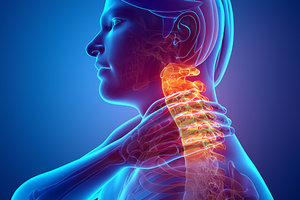The trend in the treatment of chronic neck and back pain continues to embrace a multimodal approach. Lifestyle management, nutrition, exercise and postural correction are all at the forefront. As doctors of chiropractic, we own this arena and have a "secret weapon" – the adjustment – which when properly applied, elevates our outcomes significantly.
Rethinking the Traditional Model?
The traditional model of the specificity of the chiropractic adjustment, i.e., using a specific contact to create a specific change in juxtaposition of one vertebra relative to the one above or below, does not seem to be surviving the test of time and the current knowledge base. However, creating motion at abnormally hypomobile segments, stimulating the mechanoreceptors and increasing afferent input into the CNS clearly do have significant effects. Restoring segmental and regional motion is then combined with movement repatterning (exercises), which further floods the CNS with appropriate afferent input. The chiropractic adjustment remains king of the manual therapy hill.
 We have all come across that patient who has neck pain and "just does not like their neck adjusted" with a high-velocity, low-amplitude CMT; or the neck pain patient who "just doesn't get better even though he/she has been getting adjusted." Let's take a moment to look at neck pain protocols in the research and perhaps we can revisit these patients.
We have all come across that patient who has neck pain and "just does not like their neck adjusted" with a high-velocity, low-amplitude CMT; or the neck pain patient who "just doesn't get better even though he/she has been getting adjusted." Let's take a moment to look at neck pain protocols in the research and perhaps we can revisit these patients.
Muscle Strengthening
In a previous article (July 2020), I reviewed the use of reactive isometric exercises as described by Landen-Ludvigssson in the management of chronic neck pain and whiplash-related disorders. The article discussed the importance of strengthening the deep cervical flexor (DCF) and cervical extensor muscle groups.
Clinical Tip: The cervical extensors maintain the cervical lordosis. Therefore, be sure to address cervical extensor strength in patients with a loss of the cervical lordosis. A sign of weakness may be fatty infiltration of the cervical extensors on MRI.
In addition, there is Janda's upper-crossed postural distortion, in which tightness in the suboccipital, upper trapezius, levator scapulae and pectoral muscles combines with weakness in the middle / lower trapezius, deep cervical flexors and rhomboids. The result: anterior head carriage, rounded shoulders and associated pain patterns – both locally and regionally. The Janda approach involves movement repatterning and corrective exercises.
Clinical Tip: When strengthening the middle and lower trapezius, it is essential to limit recruitment of the upper trapezius for maximal results.
Lack of endurance and strength of the neck muscles has also been demonstrated to be present in the chronic neck pain patient. DCF assessment and training with an air bladder biofeedback device is an accepted protocol. The objective in DCF strengthening is to limit activation of the SCM and anterior scalenes.
However, while DCF training can successfully address impaired neuromuscular coordination, it does not address cervical flexor strength and endurance at higher contraction intensities. For these cases, Blomgren advises a multimodal training regimen of strength, endurance, proprioception and movement repatterning for neck pain.
Clinical Tip: Chronic neck pain is associated with a lack of motion. As a general rule, restore motion; then strengthen. Once strengthening begins, be attentive to ensure motion and movement patterns continue to improve.
CMT Is Still Essential
Research has shown that CMT is beneficial in the reduction of neck pain. Lee did a study with three cohorts for the treatment of nonspecific neck pain: 1) home exercises with a biofeedback device to ensure proper DCF activation; 2) DCF exercises under supervision and thoracic manipulation; and 3) supervised DCF training. He found "thoracic manipulation combined with deep craniocervical flexor training was a more effective intervention for pain relief and improving the range of motion, muscle function, and neck disability of patients with nonspecific chronic neck pain."
In another article, Cho found "The combination of upper cervical and upper thoracic spine mobilization indicated better overall short-term outcomes in cranio-vertebral angle, neck pain, respiratory function, and overall improvement compared with DCF exercise only in patients with forward head posture."
Biomechanically, there is a coupled relationship between the mobility of the cervical spine with mobility of T1-4. As clinicians, we need to determine if the primary chiropractic dysfunction is thoracic, cervical, TMJ or even the shoulder girdle.
Specifically, if the thoracic spine is hypomobile, once adjusted the cervical ROM and symptoms will reduce. Conversely, if the cervical spine has degenerative changes, consider mobilization, instrument-assisted soft-tissue mobilization (IASTM) or SOT stair step to restore motion and decrease symptoms. Finally, since the suboccipital region has an extensive concentration of mechanoreceptors, an upper cervical toggle may be indicated as well.
Clinical Tip: Deficient cervical ROM can be simply a loss of motion or related to weak spinal stabilizers. The differential is to check active cervical ROM standing versus active ROM supine and passive ROM supine. A true loss of mobility (joint or soft tissue) ROM will be the same in all three positions. If the patient has greater ROM non-weight-bearing or with passive motion, consider weakness in the posterior stabilization chain as the culprit.
Practical Takeaway
The bottom line in treating the chronic neck pain patient is to take the time to review your chiropractic differential diagnosis. Perhaps the primary joint restrictions are thoracic, not cervical. Perhaps the cervical spine needs soft-tissue treatment, not CMT. Perhaps the C1-occiput is hypomobile. Perhaps it is a postural or TMJ issue. Perhaps you need to learn different cervical spine CMT techniques or simply improve your current skill set.
Exercise and CMT are the answer for the chronic neck pain sufferer. The studies indicate a combination of cervical stability training with upper thoracic manipulation is more helpful for the improvement of proprioception and pain reduction than cervical stability training alone. Therefore, looking back on the patient who "just doesn't like neck adjustments," it could be they need CMT elsewhere with soft-tissue treatment and corrective exercises of the cervical spine.
Resources
- Blomgren J, Strandell E, Jull G, et al. Effects of deep cervical flexor training on impaired physiological functions associated with chronic neck pain: a systematic review. BMC Musculoskelet Disord, 2018;19:415.
- Cho J, Lee E, Lee S. Upper cervical and upper thoracic spine mobilization versus deep cervical flexors exercise in individuals with forward head posture: a randomized clinical trial investigating their effectiveness. J Back Musculoskelet Rehabil, 2019;32(4):595-602.
- Landen-Ludvigssson M, Peterson G, Widh S, et al. Exercise, headache, and factors associated with headache in chronic whiplash: analysis of a randomized clinical trial. Medicine, 2019 Nov;98(48):e18130.
- Lee KW, Kim WH. Effect of thoracic manipulation and deep craniocervical flexor training on pain, mobility, strength, and disability of the neck of patients with chronic nonspecific neck pain: a randomized clinical trial. J Phys Ther Sci, 2016 Jan;28(1):175-80.
- Park SH, Lee M. Effects of lower trapezius strengthening exercises on pain, dysfunction, posture alignment, muscle thickness and contraction rate in patients with neck pain: randomized controlled trial. Med Sci Monit, 2020 Mar 23;26:e920208.
- Yang J, Lee B, Kim C. Changes in proprioception and pain in patients with neck pain after upper thoracic manipulation. J Phys Ther Sci, 2015 Mar;27(3):795-8.
Click here for more information about Donald DeFabio, DC, DACBSP, DABCO.





